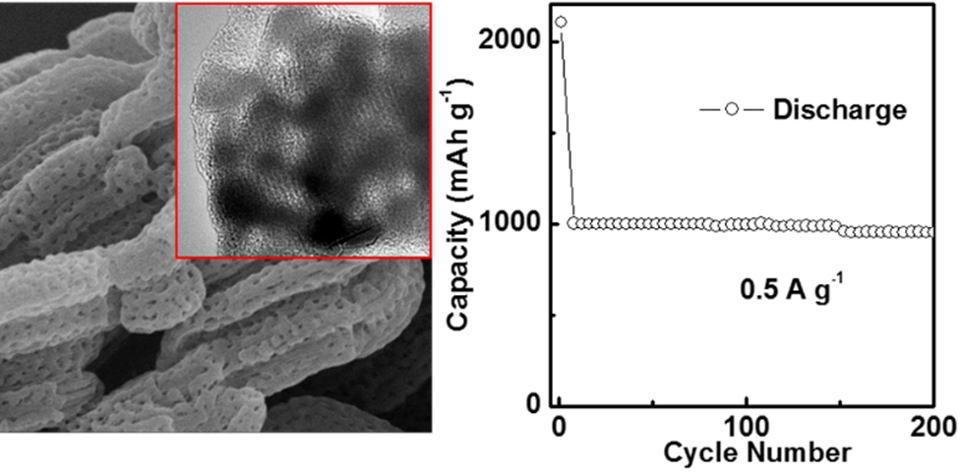

高体积比容量二氧化锡颗粒嵌入碳包覆介孔氧化亚硅棒锂离子电池负极研究
收稿日期: 2024-10-17
修回日期: 2024-12-30
录用日期: 2025-01-03
网络出版日期: 2025-01-13
SnO2 Particles Embedded into Carbon Coated Mesoporous SiOx Rod as High Volumetric Capacity Anode for Lithium-Ion Batteries
Received date: 2024-10-17
Revised date: 2024-12-30
Accepted date: 2025-01-03
Online published: 2025-01-13
与锂离子电池硅负极材料相比,氧化亚硅(SiOx)因其高比容量(1965 mAh·g−1)和适中的体积膨胀(160%)等优点而受到广泛关注。将二氧化硅(SiO2)还原制备成SiOx,并同时保持SiO2原有的纳米形貌,可以减弱硅负极材料的体积膨胀,是发展高性能负极材料的有效策略。本文选择以介孔SiO2棒为原料,通过一步高温退火法,将二氧化锡(SnO2)颗粒嵌入碳涂层,制备了介孔SiOx-SnO2@C棒复合材料。将其作为锂离子电池负极材料,具有以下结构优点:SnO2颗粒弥散分布于棒的体相中,增加了体积能量密度;包覆的碳层能有限维持SiOx在嵌脱锂过程中的结构稳定性;介孔通道有利于提高锂离子扩散速率并缓冲体积膨胀。利用这些结构特性,在0.1 A·g−1电流密度下,其重量和体积比容量分别高达1271 mAh·g-1和1573 mAh·cm-3,且历经200个循环后,容量保持率为95%。

郭家林 , 李妮妮 , 郑鹏 . 高体积比容量二氧化锡颗粒嵌入碳包覆介孔氧化亚硅棒锂离子电池负极研究[J]. 电化学, 2025 , 31(2) : 2410171 . DOI: 10.61558/2993-074X.3520
Due to the high capacity and moderate volume expansion of silicon protoxide SiOx (160%) compared with that of Si (300%), reducing silicon dioxide SiO2 into SiOx while maintaining its special nano-morphology makes it attractive as an anode of Li-ion batteries. Herein, through a one-pot facile high-temperature annealing route, using SBA15 as the silicon source, and embedding tin dioxide SnO2 particles into carbon coated SiOx, the mesoporous SiOx-SnO2@C rod composite was prepared and tested as the anode material. The results revealed that the SnO2 particles were distributed uniformly in the wall, which could further improve their volume energy densities. The coated carbon plays a role in maintaining structural integrality during lithiation, and the rich mesopores structure can release the expanded volume and enhance Li-ion transfer. At 0.1 A·g-1, the gravimetric and volumetric capacities of the composite were as high as 1271 mAh·g-1and 1573 mAh·cm-3, respectively. After 200 cycles, the 95% capacity could be retained compared with that upon the 2nd cycle at 0.5 A·g-1. And the rod morphology was well kept, except that the diameter of the rod was 3 times larger than its original size after the cell was discharged into 0.01 V.

Key words: Carbon coating; Mesoporous SiOx; Anode; Li-ion battery
/
| 〈 |
|
〉 |